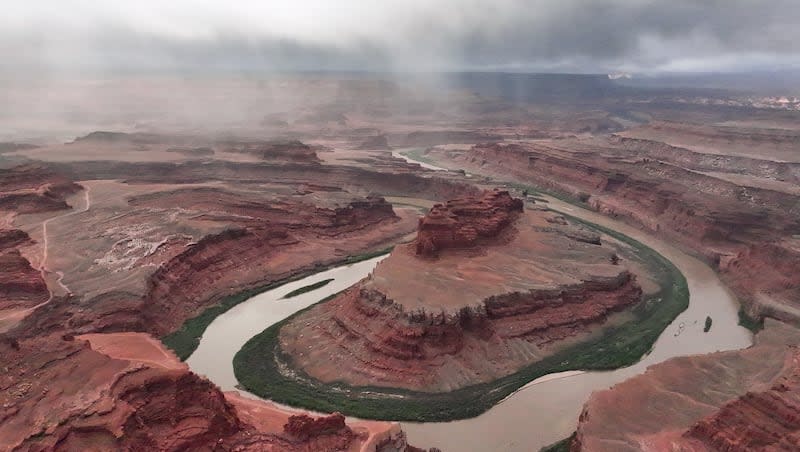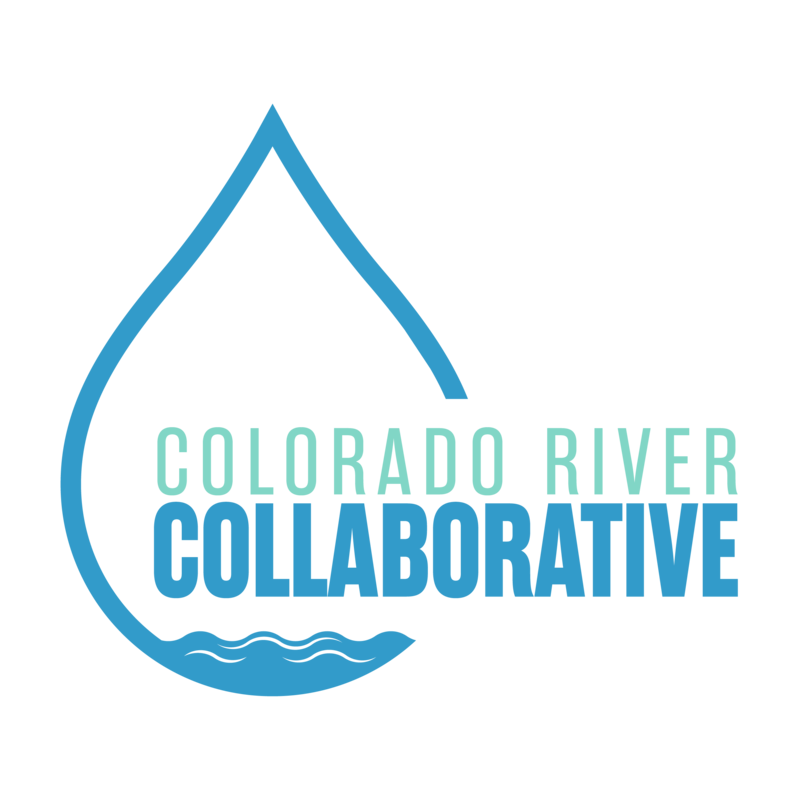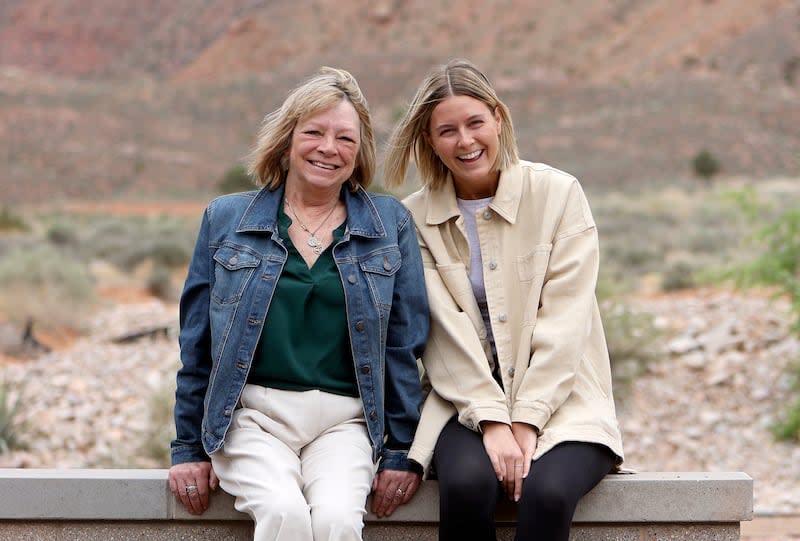Generations past, generations to come: What two reporters took away from a Colorado River trip

This article is published through the Colorado River Collaborative, a solutions journalism initiative supported by the Janet Quinney Lawson Institute for Land, Water, and Air at Utah State University. See all of our stories about how Utahns are impacted by the Colorado River at greatsaltlakenews.org.

Amy Joi O’Donoghue: I have been on the Colorado River a few times, the first in 2014. It is hard to believe that in August, it will represent a decade of dipping my toes in the water, so to speak, to better understand this complex river described as the “Workhorse of the West.”
This river, at 1,450 miles, is often referred to as the lifeblood of a rapidly growing region of the United States. Arizona’s population is exploding, Utah consistently ranks as the fastest growing state in the nation and New Mexico, Colorado and Nevada are suffering from growing pains.
Suffice it to say, the West needs the river to thrive. The West needs the river to be generous, supported by bountiful snowpacks in the Upper Basin to support growth.
In 2014, I was with then Rep. Jason Chaffetz, R-Utah, who had invited a prominent Democratic lawmaker from the East Coast to enlighten him on the struggles of the West.
Rep. Elijah Cummings, D-Md., has sadly since died. But at the time, he said his experience in Utah was an eye-opener.
The two lawmakers and local elected officials took a meandering ride along a stretch of the river, treated to a spectacular light show that highlighted the brilliance of the vermillion canyon walls.
I don’t think I got wet at all.
Fast forward to a Moab training workshop April 25-26 launched by a new initiative called the Colorado River Collaborative, which featured another trip on the Colorado.
My colleague, Emma Pitts, shares my passion for reporting, for good journalism. But we are worlds apart.
I will turn 60 this month, a Utah native. Emma recently turned 24, graduated as an English major from Utah Valley University and is from Oklahoma. It was her first time on the river. On our first assignment, I thought I could teach her; she ended up teaching me with her wide-open curiosity and thoughtful questions. There is a way to teach an old dog new tricks.

Emma’s first impressions
Emma Pitts: Like Moab, Oklahoma is known for its red port soil, which covers most of my home state. Both are caused by iron oxide in their composition, but that’s as far as I can compare the two.
As we drove through the canyon up Kane Creek Boulevard up against the Colorado River, it was — for lack of a better term — a humbling experience.
I grew up with a father whose idea of a family vacation was road-tripping 13-plus hours to Grand Canyon National Park. My little sister had hiked Havasu Falls in the Grand Canyon by age 5 and the 24-mile rim-to-rim hike by age 11. That said, I have been surrounded by massive red rock formations and powerful water currents a couple of times in my life, but they never fail to remind me how powerless humans are against the rugged Western landscape.
Amy Joi’s experience on the river
AJO: I was bundled up from head to toe but it felt, as we hurled through some rapids, the chill ate my bones. Emma was wearing shorts and a long-sleeved shirt. We both had our ball caps on.
EP: Perhaps not the wisest attire for rafting in late April. I joked with Brian Steed, who is the executive director of the Janet Quinney Lawson Institute of Land, Water, and Air at Utah State University, that it was the redneck in me that was tough enough to handle the cold currents.
But I wasn’t too focused on whether I was cold or not when I was on the river anyway — there was too much to take in, from wildlife to landscape.
To me, there was something almost comical, too, about a dozen or so journalists — many having met for the first time — coasting along the Colorado River together. It was a new and unique experience and exciting, to say the least.
Saving the ‘Jesus hat’
AJO: So, as we ran this river courtesy of Holiday River Expeditions and their seasoned guides, I fought to keep my balance. A fused spine and neuropathy due to chemotherapy have left their individual footprints on my health.
I was in the back of the boat, while Emma gleefully sat up front, smiling, taking in the experience without fear. My main goal was to stay in the boat, even if it meant sitting down and soaking my buttocks.
Then, the wind whipped up and my favorite ball cap flew forward into the boat. It was lost forever, I surmised. It was purchased in the heart of the Bible Belt and simply says: John 3:16.
“For God so loved the world, that He gave His only begotten Son, that whosoever believeth in Him should not perish, but have everlasting life.”
It’s my lucky charm.
Suddenly, Emma emerged from the front of the boat. Miraculously, she had caught the hat — and with that, we planted a generational bond.
Emma’s take on saving the ‘Jesus hat,’ the wonders of wildlife
EP: I was looking at the rapids we were approaching, calculating how wet I would probably get, when I heard the raft guide yell, “Someone get that hat!” I only got my sleeve wet. I would’ve jumped in for Amy Joi’s hat, but being close to 5-foot-10, my long arms came in handy and, ultimately, saved the Jesus hat.
In the short time we were on the raft, we saw different breeds of cranes along the banks, two bald eagles flying overhead and a plump beaver sitting in the water, the first time I’d ever seen one in the wild. Animals who call national parks home must be pretty used to human traffic, but unlike a zoo, we were in their territory. They knew it, and we did too.
AJO: The Colorado River Collaborative, thanks to funding from Utah State University, aims to bring competing newsrooms together to share stories, share ideas, and define solutions — some uncomfortable — to help understand the river and its challenges.
About the Colorado River Collaborative
Like the river itself, the collaborative is navigating a delicate balance of making sure reporters get their own stories, promote individual perspectives. And Heather May, our leader, is an absolute hero by diplomatically herding us toward our goals.
“By reporting on potential solutions, we want to show how Utahns can address a dwindling water supply. This doesn’t mean we will take sides on what solutions would work or not,” May said. “But we want to show how individuals and organizations are responding to the crisis and if their responses are working.”
EP: One of my favorite things about being a journalist is meeting so many people with different perspectives, experiences, expertise and sharing their stories. I kept thinking the entire trip, “How lucky am I?” People go their whole lives without seeing incredible landscapes like those around Moab. Here I was, a new journalist from Oklahoma, bumping shoulders on a raft with people who care so much about the future of the Colorado River and surrounding areas and have spent their careers devoting time and energy to environmental causes.
I am still nowhere near understanding the complexities of water and all it entails — who gets it, how much they get, what happens when it runs out. To Amy Joi’s amusement, I probably looked at her with a face of pure puzzlement at least a dozen times, her knowledge and patience I am forever grateful for. But not everyone has to be a water or Colorado River expert to know they have skin in the game. That is perhaps the most important lesson I learned from the collaborative.
The Colorado River flows through 11 national parks and monuments. As the river changes, the reality is that with it, so does the landscape and native wildlife in or out of the river that millions of people around the world come to experience every year. You don’t have to be one of the seven basin states the Colorado River irrigates to to be affected by its changes.
At the end of the day
AJO: After the trip had ended and we had more discussions and fajitas, the entire group scattered as if they were race horses bolting from the starting gate.
I was tired and exhausted when I hit the road. The fading sun clouded my vision. Navigating twists and turns, I let my car go slow, much to the disgust of more seasoned motorists on this stretch of highway who repeatedly passed me.
I could make out the ebbs and flows of the river. It was so peaceful, so compelling, I pulled over the car and plugged in what I thought was an apt song.
“The Last Resort” was written by Eagles members Don Henley and Glenn Frey.
Some could call it an environmental activist song, but I think it is a call to reality, describing the near obliteration of Native American tribes and the settlement of the West by East Coast settlers.
The point at the end of the song is poignant and so relative to the Colorado River, noting there is no new frontier, we have got to make it here.
“Who will provide the grand design?
What is yours and what is mine?
And you can see them there on Sunday morning, and stand up and sing about what it’s like up there. They call it paradise, I don’t know why. You call it paradise, kiss it goodbye”
The collaborative does not want to put a simple peck on the cheek with the Colorado River. We just want you to understand that it’s paradise. We do not want to kiss it goodbye. We can’t afford to.

